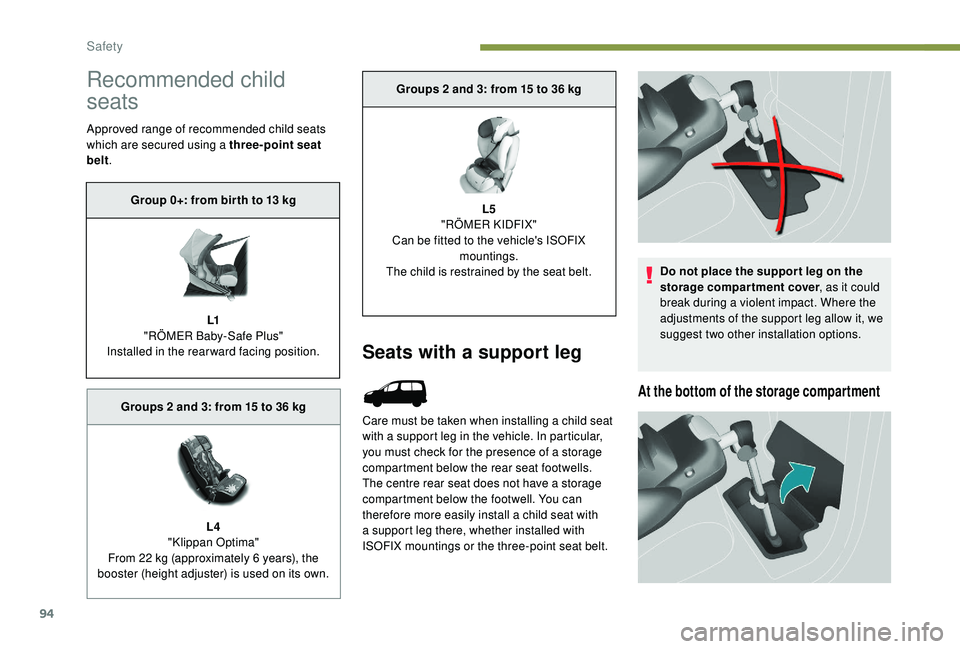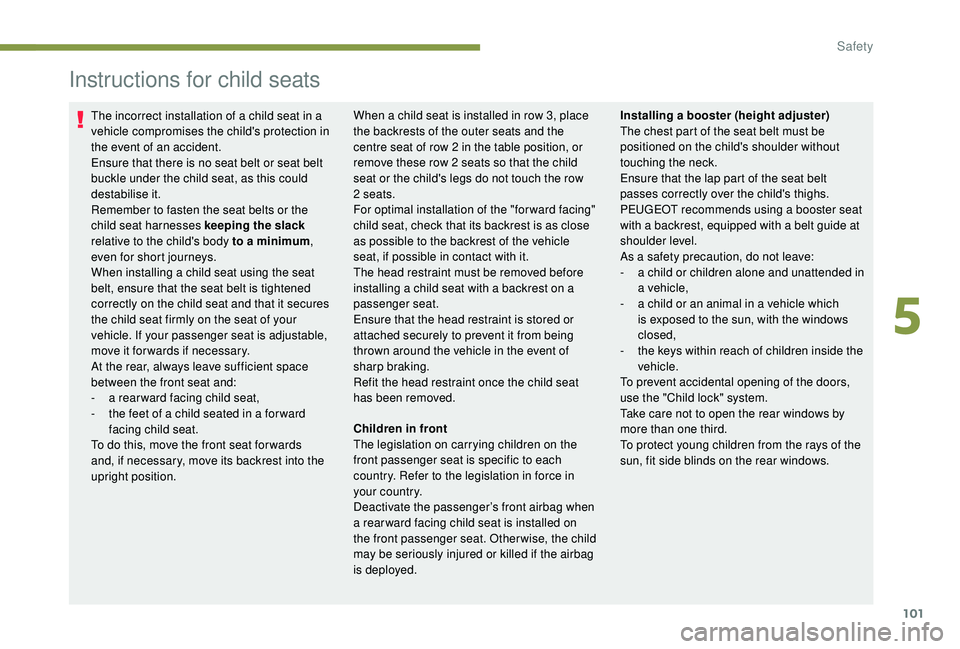Page 96 of 216

94
Recommended child
seats
Approved range of recommended child seats
which are secured using a three-point seat
belt.
Seats with a support leg
Care must be taken when installing a child seat
with a support leg in the vehicle. In particular,
you must check for the presence of a storage
compartment below the rear seat footwells.
The centre rear seat does not have a storage
compartment below the footwell. You can
therefore more easily install a child seat with
a support leg there, whether installed with
ISOFIX mountings or the three-point seat belt. Do not place the suppor t leg on the
storage compartment cover
, as it could
break during a violent impact. Where the
adjustments of the support leg allow it, we
suggest two other installation options.
At the bottom of the storage compartment
Group 0+: from bir th to 13 kg
L1
"
RÖMER Baby-Safe Plus"
Installed in the rearward facing position.
Groups 2 and 3: from 15 to 36
kg
L4
"Klippan Optima"
From 22
kg (approximately 6 years), the
booster (height adjuster) is used on its own. Groups 2 and 3: from 15 to 36
kg
L5
"RÖMER KIDFIX"
Can be fitted to the vehicle's ISOFIX mountings.
The child is restrained by the seat belt.
Safety
Page 103 of 216

101
Instructions for child seats
The incorrect installation of a child seat in a
vehicle compromises the child's protection in
the event of an accident.
Ensure that there is no seat belt or seat belt
buckle under the child seat, as this could
destabilise it.
Remember to fasten the seat belts or the
child seat harnesses keeping the slack
relative to the child's body to a minimum,
even for short journeys.
When installing a child seat using the seat
belt, ensure that the seat belt is tightened
correctly on the child seat and that it secures
the child seat firmly on the seat of your
vehicle. If your passenger seat is adjustable,
move it for wards if necessary.
At the rear, always leave sufficient space
between the front seat and:
-
a r
ear ward facing child seat,
-
t
he feet of a child seated in a for ward
facing child seat.
To do this, move the front seat for wards
and, if necessary, move its backrest into the
upright position. When a child seat is installed in row 3, place
the backrests of the outer seats and the
centre seat of row 2 in the table position, or
remove these row 2 seats so that the child
seat or the child's legs do not touch the row
2 seats.
For optimal installation of the "forward facing"
child seat, check that its backrest is as close
as possible to the backrest of the vehicle
seat, if possible in contact with it.
The head restraint must be removed before
installing a child seat with a backrest on a
passenger seat.
Ensure that the head restraint is stored or
attached securely to prevent it from being
thrown around the vehicle in the event of
sharp braking.
Refit the head restraint once the child seat
has been removed.
Installing a booster (height adjuster)
The chest part of the seat belt must be
positioned on the child's shoulder without
touching the neck.
Ensure that the lap part of the seat belt
passes correctly over the child's thighs.
PEUGEOT recommends using a booster seat
with a backrest, equipped with a belt guide at
shoulder level.
As a safety precaution, do not leave:
-
a c
hild or children alone and unattended in
a vehicle,
-
a c
hild or an animal in a vehicle which
is exposed to the sun, with the windows
closed,
-
t
he keys within reach of children inside the
vehicle.
To prevent accidental opening of the doors,
use the "Child lock" system.
Take care not to open the rear windows by
more than one third.
To protect young children from the rays of the
sun, fit side blinds on the rear windows.
Children in front
The legislation on carrying children on the
front passenger seat is specific to each
country. Refer to the legislation in force in
your country.
Deactivate the passenger’s front airbag when
a rear ward facing child seat is installed on
the front passenger seat. Otherwise, the child
may be seriously injured or killed if the airbag
is deployed.
5
Safety
Page 106 of 216

104
In some cases of particularly demanding use
(when towing the maximum load on a steep
gradient in high temperatures), the engine
power is automatically limited. In such a case,
the air conditioning is automatically switched
off to increase the available engine power.F
I
f this warning lamp and the
STOP warning lamp come on,
stop the vehicle and switch off
the engine as soon as possible.
New vehicle
Do not pull a trailer before having driven at
least 620
miles (1,000 kilometres).
Braking
Towing a trailer increases the braking distance.
To avoid overheating of the brakes, the use of
engine braking is recommended.
Ty r e s
F Check the tyre pressures of the towing vehicle and of the trailer, observing the
recommended pressures.
Lighting
F Check the electrical lighting and signalling on the trailer and the headlamp beam height
of your vehicle. For more information on adjusting
the Headlamp beam
, refer to the
corresponding section.
The rear parking sensors will be
deactivated automatically to avoid the
audible signal if a genuine PEUGEOT
towbar is used.
Starting and stopping
Running and accessories position.
To unlock the steering, turn the steering wheel
gently while turning the key, without forcing. In
this position, certain accessories can be used. Starting position.
The starter is operated. the engine turns over,
release the key.
STOP position
: anti-theft.
The ignition is off. Turn the steering wheel until
the steering column locks. Remove the key.
If this warning lamp comes on, a door
or the bonnet is not closed correctly.
Please check!Diesel engines
If the temperature is high enough,
the warning lamp comes on for
less than a second, you can start
without waiting.
In cold weather, wait for this warning lamp to go
off then operate the starter (starting position)
until the engine starts.
When switching off the ignition, let the
engine run for a few seconds to allow the
turbocharger (Diesel engine) to return to
idle.
Do not press the accelerator when
switching off the ignition.
There is no need to engage a gear after
parking the vehicle.
Driving
Page 168 of 216
166
LOverall length 4,380
H Overall height 1,8 01-1,8 62
A Wheelbase 2,728
B Front overhang 925
C Rear overhang 727
D Width over panels without mirrors
1,810
with mirrors 2 ,112
E Front track width 1,505-1,507
F Rear track width 1,5 5 4 -1,5 5 6
- Length of the loading sur face up to the seat Row 2
990
Row 2, seat in the fully folded position 1,3 4 3
With front passenger seat folded 3,000
Technical data
Page 169 of 216
167
Rear doors (mm)Side-hinged doorsTailgate
Small Large
M
Maximum boot sill height with
205/65 R15 tyres and tailgate trim582
N Useable height of the opening
(under panel) 1,11 8
O Useable width 4955431,5 82
9
Technical data
Page 170 of 216
168
Sliding side doors (mm)
PUseable height 1,0 0 9
Q Useable width 640
- Height under raised tailgate 1,8 92
Technical data
Page 172 of 216
170
Shor t – L1Long – L2
625 850 750
L Overall length 4,3804,628
H Overall height 1,8 0 5 -1,8 3 4
A Wheelbase 2,728
B Front overhang 925
C Rear overhang 727975
D Width over panels without mirrors
1,810
with mirrors 2 ,112
E Front track width 1,505
F Rear track width 1,5 5 4
G Rear floor useable length 1,8 0 02,050
I Useable length with front passenger seat folded 3,0003,250
Technical data
Page 173 of 216
171
Rear doors (mm)L1 – 625L1 – 850 L2
M Maximum boot sill height with
tyres 195/65 R15 584
609 612
Side-hinged doors Tailgate
Small Large
N Useable height of the opening
(under panel) 1,14 8
1,313
O Width 4955431,5 82
9
Technical data